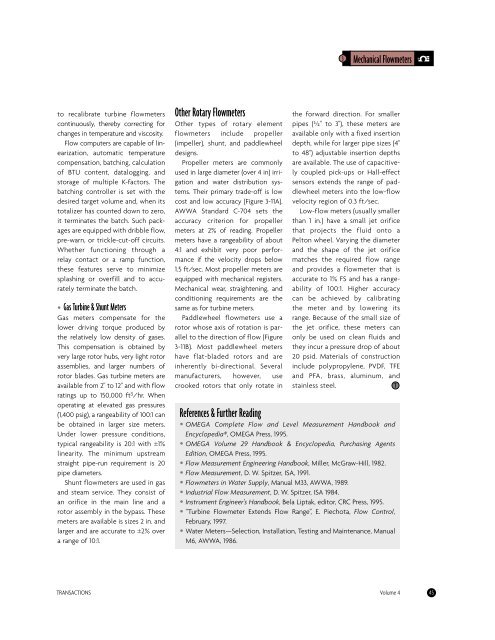flow and level measurement - Omega Engineering
flow and level measurement - Omega Engineering
flow and level measurement - Omega Engineering
Create successful ePaper yourself
Turn your PDF publications into a flip-book with our unique Google optimized e-Paper software.
to recalibrate turbine <strong>flow</strong>meters<br />
continuously, thereby correcting for<br />
changes in temperature <strong>and</strong> viscosity.<br />
Flow computers are capable of linearization,<br />
automatic temperature<br />
compensation, batching, calculation<br />
of BTU content, datalogging, <strong>and</strong><br />
storage of multiple K-factors. The<br />
batching controller is set with the<br />
desired target volume <strong>and</strong>, when its<br />
totalizer has counted down to zero,<br />
it terminates the batch. Such packages<br />
are equipped with dribble <strong>flow</strong>,<br />
pre-warn, or trickle-cut-off circuits.<br />
Whether functioning through a<br />
relay contact or a ramp function,<br />
these features serve to minimize<br />
splashing or overfill <strong>and</strong> to accurately<br />
terminate the batch.<br />
• Gas Turbine & Shunt Meters<br />
Gas meters compensate for the<br />
lower driving torque produced by<br />
the relatively low density of gases.<br />
This compensation is obtained by<br />
very large rotor hubs, very light rotor<br />
assemblies, <strong>and</strong> larger numbers of<br />
rotor blades. Gas turbine meters are<br />
available from 2" to 12" <strong>and</strong> with <strong>flow</strong><br />
ratings up to 150,000 ft 3 /hr. When<br />
operating at elevated gas pressures<br />
(1,400 psig), a rangeability of 100:1 can<br />
be obtained in larger size meters.<br />
Under lower pressure conditions,<br />
typical rangeability is 20:1 with ±1%<br />
linearity. The minimum upstream<br />
straight pipe-run requirement is 20<br />
pipe diameters.<br />
Shunt <strong>flow</strong>meters are used in gas<br />
<strong>and</strong> steam service. They consist of<br />
an orifice in the main line <strong>and</strong> a<br />
rotor assembly in the bypass. These<br />
meters are available is sizes 2 in. <strong>and</strong><br />
larger <strong>and</strong> are accurate to ±2% over<br />
a range of 10:1.<br />
Other Rotary Flowmeters<br />
Other types of rotary element<br />
<strong>flow</strong>meters include propeller<br />
(impeller), shunt, <strong>and</strong> paddlewheel<br />
designs.<br />
Propeller meters are commonly<br />
used in large diameter (over 4 in) irrigation<br />
<strong>and</strong> water distribution systems.<br />
Their primary trade-off is low<br />
cost <strong>and</strong> low accuracy (Figure 3-11A).<br />
AWWA St<strong>and</strong>ard C-704 sets the<br />
accuracy criterion for propeller<br />
meters at 2% of reading. Propeller<br />
meters have a rangeability of about<br />
4:1 <strong>and</strong> exhibit very poor performance<br />
if the velocity drops below<br />
1.5 ft/sec. Most propeller meters are<br />
equipped with mechanical registers.<br />
Mechanical wear, straightening, <strong>and</strong><br />
conditioning requirements are the<br />
same as for turbine meters.<br />
Paddlewheel <strong>flow</strong>meters use a<br />
rotor whose axis of rotation is parallel<br />
to the direction of <strong>flow</strong> (Figure<br />
3-11B). Most paddlewheel meters<br />
have flat-bladed rotors <strong>and</strong> are<br />
inherently bi-directional. Several<br />
manufacturers, however, use<br />
crooked rotors that only rotate in<br />
3 Mechanical Flowmeters<br />
the forward direction. For smaller<br />
pipes (H" to 3"), these meters are<br />
available only with a fixed insertion<br />
depth, while for larger pipe sizes (4"<br />
to 48") adjustable insertion depths<br />
are available. The use of capacitively<br />
coupled pick-ups or Hall-effect<br />
sensors extends the range of paddlewheel<br />
meters into the low-<strong>flow</strong><br />
velocity region of 0.3 ft/sec.<br />
Low-<strong>flow</strong> meters (usually smaller<br />
than 1 in.) have a small jet orifice<br />
that projects the fluid onto a<br />
Pelton wheel. Varying the diameter<br />
<strong>and</strong> the shape of the jet orifice<br />
matches the required <strong>flow</strong> range<br />
<strong>and</strong> provides a <strong>flow</strong>meter that is<br />
accurate to 1% FS <strong>and</strong> has a rangeability<br />
of 100:1. Higher accuracy<br />
can be achieved by calibrating<br />
the meter <strong>and</strong> by lowering its<br />
range. Because of the small size of<br />
the jet orifice, these meters can<br />
only be used on clean fluids <strong>and</strong><br />
they incur a pressure drop of about<br />
20 psid. Materials of construction<br />
include polypropylene, PVDF, TFE<br />
<strong>and</strong> PFA, brass, aluminum, <strong>and</strong><br />
stainless steel. T<br />
References & Further Reading<br />
• OMEGA Complete Flow <strong>and</strong> Level Measurement H<strong>and</strong>book <strong>and</strong><br />
Encyclopedia®, OMEGA Press, 1995.<br />
• OMEGA Volume 29 H<strong>and</strong>book & Encyclopedia, Purchasing Agents<br />
Edition, OMEGA Press, 1995.<br />
• Flow Measurement <strong>Engineering</strong> H<strong>and</strong>book, Miller, McGraw-Hill, 1982.<br />
• Flow Measurement, D. W. Spitzer, ISA, 1991.<br />
• Flowmeters in Water Supply, Manual M33, AWWA, 1989.<br />
• Industrial Flow Measurement, D. W. Spitzer, ISA 1984.<br />
• Instrument Engineer’s H<strong>and</strong>book, Bela Liptak, editor, CRC Press, 1995.<br />
• “Turbine Flowmeter Extends Flow Range”, E. Piechota, Flow Control,<br />
February, 1997.<br />
• Water Meters—Selection, Installation, Testing <strong>and</strong> Maintenance, Manual<br />
M6, AWWA, 1986.<br />
TRANSACTIONS Volume 4 45

















